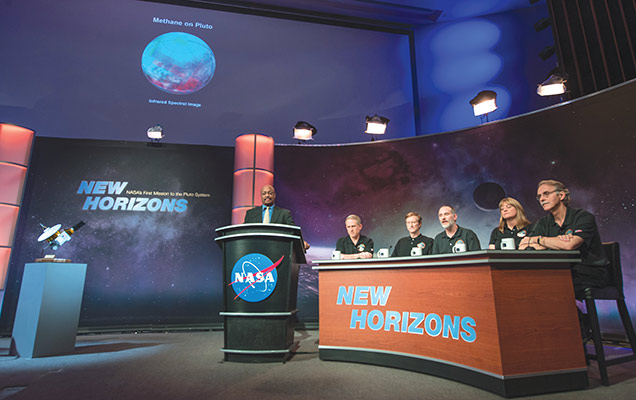The summer of stupendous science
 CREDIT: NASA HQ PHOTO
CREDIT: NASA HQ PHOTONew Horizons media briefing on July 15 about the probe's trip to Pluto, which produced the most pristine photos of the cold planet ever documented.
The summer is a time for beach days, working a minimum wage job and generally goofing off until you remember needing to apply for OSAP. If that sounded like your summer this article is meant to give you a quick update on the scientific discoveries you may have missed this summer.
Space
On August 10 there was the extraordinary discovery of astronauts eating vegetables, red and romaine lettuce to be exact. Growing the leafy purple-red plant was a new experiment into maintaining self-sufficiency off-planet, a renowned first in NASA history.
While plants have been grown in space before, this is the first time an experiment has resulted in the ability to consume the final product.
The plants were grown within special UV-light chambers, optimizing growth parameters for the lettuces chlorophyll food factories.
Due to this energy optimization, the romaine lettuce was able to reach a larger, healthier size, growing in only 33 days.
In addition to eating the lettuce, microbial swabs were taken on various sections of the test, while half the remaining leaves were frozen for Earth-side researchers to study, giving a look into the feasibility of growing food on the way to Mars.
After nine years of flinging itself towards the outer regions of our solar system, NASA’s New Horizons probe reached the tiny dwarf planet Pluto and its neighbour moon Charon.
Flying past the planetoid at 23 km per second, New Horizons gave humans the most pristine images of the icy surface ever documented.
The probe reached its closest distance of 12,500 km to Pluto on July 14, sending back images of a slightly pinkish surface as well as features not expected, including a large smooth heart-shaped section in the southern hemisphere.
The probe will continue out towards the Kuiper’s Belt, a ring of rocky objects left over from the creation of our solar system 4.6 billion years ago.
While travelling to the fringes of the solar system, New Horizons will be sending back gigabytes of data from its flyby of the cold tiny duo, more than enough for planetary astronomers and geologists to analyze for a couple lifetimes.
The conjunction, when two celestial bodies appear close together in the sky, of Venus and Jupiter during the months June and July was historical. On July 1, the planets reached their closest, and the two could be seen with binoculars and telescopes, appearing to be less than one-third a degree from each other. It has been 2,200 years since the planets have been seen this close together.
Robotics
The semi-secretive U.S. military research offshoot – the Defence Advanced Research Projects Agency (DARPA) – held its Robotics Challenge Finals in Paloma, Calif. in early June.
Technically starting in 2012 after Fukushima emergency response robots were deemed ineffective at their jobs, the finals saw 23 teams from around the world having to complete one of four disaster simulation courses, each with eight challenges built in, in under an hour.
Challenges consisted of entering, turning on and driving an ATV, plugging electrical cords into sockets, crawling over and clearing rubble piles, as well as other disaster- related challenges.
Team Kaist from South Korea with its robot DRC-Hubo finished first, winning the $2-million grand prize.
Living things
In early August, a paper published by Current Biology focused on a chief field researcher experience while gathering specimens few hours away from Maceió, Brazil. Dr. Carlos Jared, a herpetologist from the Institute of Butantan of Sao Paulo, saw the frog he was handling, the Corythomantis greeningi, secrete poisonous mucous from spines on its face.
After the frog pricked Jared, he spent five terrifying and painful hours unable to get to a doctor. The herpetologist survived but had questions.
It was found that that species and another, Aparasphenodon brunoi, are venomous. Lots of frogs are poisonous in that they exude poison from their skin, but a venomous animal has ways to actively inject poison into its victims.
The main route of entry is a tiny bone spine on the edge of the frog’s skull. When the frog flexes muscles in its neck, these spikes push the venom out into the mucous, also injecting whatever it touches.
Jared was lucky and his team ultimately discovered the Corythomantis greeningi was the less venomous of the two specimens found, while Aparasphenodon brunoi’s liquid was more deadly than a pit viper’s bite.
Like every semester, the summer was filled with amazing discoveries, but scientists will always be discovering, so don’t stop at this list, get excited and get looking at what is happening today because it is influencing tomorrow’s scientific pursuits.














